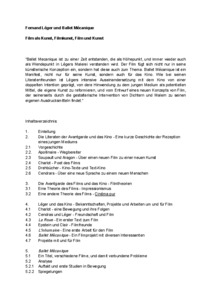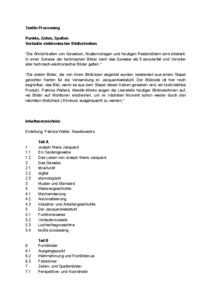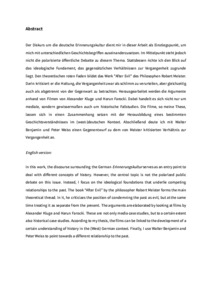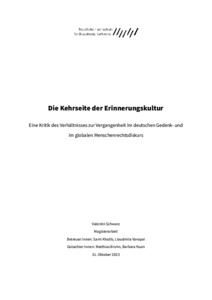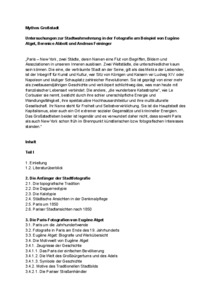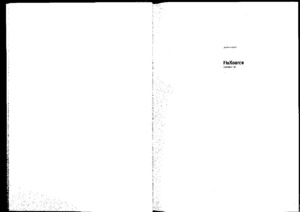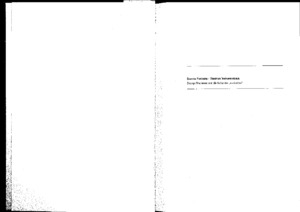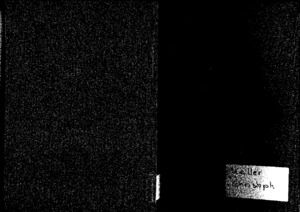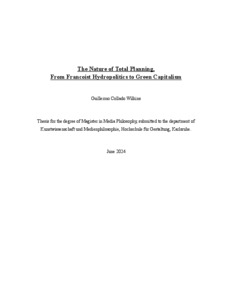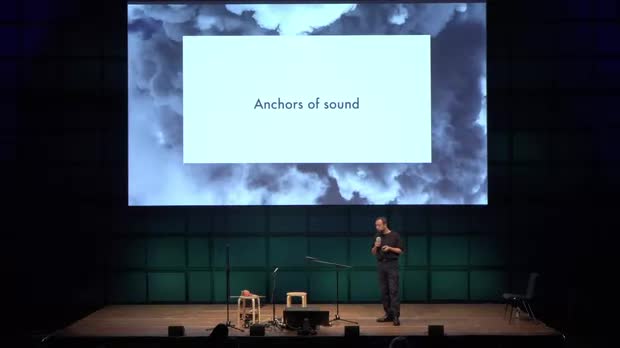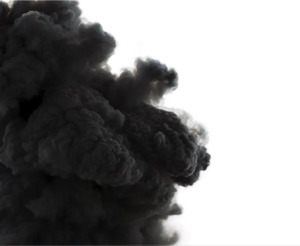"Theorie"
| Begriff | Theorie |
| Metakey | Kategorie (institution:project_category) |
| Typ | Keyword |
| Vokabular | HfG |
85 Inhalte
- Seite 1 von 8
Fernand Léger und Ballet Mécanique (Inhaltsverzeichnis)
- Titel
- Fernand Léger und Ballet Mécanique (Inhaltsverzeichnis)
- Untertitel
- Film als Kunst, Filmkunst, Film und Kunst
- Autor/in
- Beschreibung (de)
- "Ballet Mecanique ist zu einer Zeit entstanden, die als Höhepunkt, und immer wieder auch als Wendepunkt in Légers Malerei verstanden wird. Der Film fügt sich nicht nur in seine künstlerische Konzeption ein, sondern hat diese auch zum Thema. Ballet Mécanique ist ein Manifest, nicht nur für seine Kunst, sondern auch für das Kino. Wie bei seinen Literatenfreunden ist Légers intensive Auseinandersetzung mit dem Kino von einer doppelten Intention geprägt, von dere Hinwendung zu dem jungen Medium als potentiellen Mittel, die eigene Kunst zu reformieren, und vom Entwurf eines neuen Konzepts von Film, der seinerseits durch die gestalterische Intervention von Dichtern und Malern zu seinen eigenen Ausdrucksmitteln findet."
- Beschreibung (en)
- "Ballet Mecanique was created at a time that is seen as a high point, and repeatedly as a turning point, in Léger's painting. The film not only fits into his artistic conception, but also has it as its theme. Ballet Mécanique is a manifesto, not only for his art, but also for the cinema. As with his literary friends, Léger's intensive engagement with the cinema is characterisedby a dual intention: a turn towards the young medium as a potential means of reforming his own art, and the creation of a new concept of film, which in turn finds its own means of expression through the creative intervention of poets and painters."
- Kategorie
- Schlagworte
- Datierung
- Juli 1997
- Sprache
- Ort: Institution
- Stadt
- Titel
- Fernand Léger und Ballet Mécanique (Inhaltsverzeichnis)
- Urheberrechtshinweis
- Barbara Filser
- Rechtsschutz/Lizenz
- Freigabe Nutzung HfG
- Medienersteller/in
- Beziehung/Funktion
- Projektleiter/in
- Semester
- Studiengang
- Typ der Abschlussarbeit
- Archiv-Signatur
- HfG HS 1997 02
- Externes Archiv
- Importiert am
- 03.08.2023
- Übergeordnete Sets
- 1
Textile Processing
- Titel
- Textile Processing
- Untertitel
- Punkte, Zeilen, Spalten; Vorläufer elektronischer Bildtechniken
- Autor/in
- Beschreibung (de)
- „Die Ähnlichkeiten von Geweben, Mustervorlagen und heutigen Rasterbildern sind eklatant. In einer Genese der technischen Bilder kann das Gewebe als Exemplarfall und Vorreiter aller technisch-elektronischer Bilder gelten.”
„Die ersten Bilder, die von ihrem Bildkörper abgelöst wurden, bestanden aus einem Stapel gelochter Karten für die Verwendung im Jacquardwebstuhl. Der Bildcode ist hier noch begreifbar, das Bild, wenn es aus dem Stapel dieser Karten gewoben wird, ein textil-taktiles Produkt. Patricia Wallers Needle-Works zeigen die Leerstelle heutiger Bildmaschinen auf, wo Bilder auf Monitoren erscheinen, um im nächsten Moment schon wieder durch den nächsten (Netzhaut-) Eindruck ausgetauscht zu werden.”
- „Die Ähnlichkeiten von Geweben, Mustervorlagen und heutigen Rasterbildern sind eklatant. In einer Genese der technischen Bilder kann das Gewebe als Exemplarfall und Vorreiter aller technisch-elektronischer Bilder gelten.”
- Beschreibung (en)
- “The similarities between fabrics, patterns and today's raster images are striking. In the genesis of technical images, the fabric can be regarded as an exemplary case and forerunner of all technical-electronic images.”
“The first images that were detached from their image body consisted of a stack of perforated cards for use in the Jacquard loom. The image code is still comprehensible here, the image, when woven from the pile of these cards, is a textile-tactile product. Patricia Waller's needle works show the blank space of today's image machines, where images appear on monitors only to be replaced by the next (retinal) impression in the very next moment.”
- “The similarities between fabrics, patterns and today's raster images are striking. In the genesis of technical images, the fabric can be regarded as an exemplary case and forerunner of all technical-electronic images.”
- Kategorie
- Typ des Projekts/Werks
- Schlagworte
- Datierung
- 02.11.1998
- Sprache
- Ort: Institution
- Stadt
- Titel
- Textile Processing
- Urheberrechtshinweis
- Brigit Schneider
- Rechtsschutz/Lizenz
- Freigabe Nutzung HfG
- Medienersteller/in
- Beziehung/Funktion
- Projektleiter/in
- Semester
- Studiengang
- Typ der Abschlussarbeit
- Archiv-Signatur
- HfG HS 1998 02
- Externes Archiv
- Importiert am
- 04.08.2023
- Übergeordnete Sets
- 1
Abstract und Inhaltsverzeichnis von "Die Kehrseite der Erinnerungskultur"
- Titel
- Abstract und Inhaltsverzeichnis von "Die Kehrseite der Erinnerungskultur"
- Autor/in
- Kategorie
- Typ des Projekts/Werks
- Schlagworte
- Datierung
- 31.10.2023
- Bemerkungen
- Eine kondensierte Fassung des Textes wurde von "Umbau" veröffentlicht: https://umbau.hfg-karlsruhe.de/posts/die-kehrseite…
- Titel
- Abstract und Inhaltsverzeichnis von "Die Kehrseite der Erinnerungskultur"
- Titel (en)
- Abstract and table of contents of "The Other Side of Erinnerungskultur"
- Urheberrechtshinweis
- © Valentin Schwarz
- Rechtsschutz/Lizenz
- Freigabe Nutzung HfG
- Medienersteller/in
- Beziehung/Funktion
- Medien-Beschreibung
- Abstract und Inhaltsverzeichnis von "Die Kehrseite der Erinnerungskultur"
- Medien-Beschreibung (en)
- Abstract and table of contents of "The Other Side of Erinnerungskultur"
- Projektleiter/in
- Semester
- Studiengang
- Typ der Abschlussarbeit
- Importiert am
- 08.06.2024
- Übergeordnete Sets
- 1
Titelblatt zu "Die Kehrseite der Erinnerungskultur"
- Titel
- Titelblatt zu "Die Kehrseite der Erinnerungskultur"
- Autor/in
- Kategorie
- Typ des Projekts/Werks
- Schlagworte
- Datierung
- 31.10.2023
- Bemerkungen
- Eine kondensierte Fassung des Textes wurde von "Umbau" veröffentlicht: https://umbau.hfg-karlsruhe.de/posts/die-kehrseite…
- Titel
- Titelblatt zu "Die Kehrseite der Erinnerungskultur"
- Titel (en)
- Cover sheet "The Other Side of Erinnerungskultur"
- Urheberrechtshinweis
- © Valentin Schwarz
- Freigabe Nutzung HfG
- Medienersteller/in
- Beziehung/Funktion
- Medien-Beschreibung
- In dieser Arbeit setze ich mich mit unterschiedlichen Geschichtsbegriffen auseinander. Dafür dienen mir die Diskussionen um die deutsche Erinnerungskultur als Einstiegspunkt. Das Ziel ist es allerdings nicht, unmittelbar in die polarisierte Debatte einzugreifen. Stattdessen richtet sich der Fokus auf das ideologische Fundament, das verschiedenen Formen, mit der eigenen Geschichte umzugehen, zugrunde liegt. Den theoretischen roten Faden bildet das Werk "After Evil" des Philosophen Robert Meister. Darin kritisiert er die Haltung, die Vergangenheit zwar als schlimm zu verurteilen, aber gleichzeitig auch als abgetrennt von der Gegenwart zu betrachten. Herausgearbeitet werden die Argumente unter anderem anhand von Filmen von Alexander Kluge und Harun Farocki
- Medien-Beschreibung (en)
- In this work, I examine different concepts of history. The discussions surrounding the German culture of remembrance serve as my starting point. However, the aim is not to intervene directly in the polarized debate. Instead, the focus is on the ideological foundations that underlie different ways of dealing with one's own history. The work “After Evil” by philosopher Robert Meister forms the theoretical leitmotif. In it, he criticizes the position of condemning the past as evil, but treating it at the same as something that is separated from the present. The arguments are elaborated on the basis of films by Alexander Kluge and Harun Farocki, among others.
- Projektleiter/in
- Semester
- Studiengang
- Typ der Abschlussarbeit
- Importiert am
- 15.06.2024
- Übergeordnete Sets
- 1
Mythos Großstadt
- Titel
- Mythos Großstadt
- Untertitel
- Untersuchungen zur Stadtwahrnehmung in der Fotografie am Beispiel von Eugène Atget, Berenice Abbott und Andreas Feininger
- Autor/in
- Beschreibung (de)
- „Paris – New York, zwei Städte, deren Namen eine Flut von Begriffen, Bildern und Assoziationen in unserem Inneren auslösen. Zwei Weltstädte, die unterschiedlicher kaum sein können. Die eine, die verträumte Stadt an der Seine, gilt als das Mekka der Liebenden, ist der Inbegriff für Kunst und Kultur, war Sitz von Königen und Kaisern wir Ludwig XIV. oder Napoleon und blutiger Schauplatz zahlreicher Revolutionen. Sie ist geprägt von einer mehr als zweitausendjährigen Geschichte und verkörpert schlichtweg das, was man heute mit französischer Lebensart verbindet. Die andere, 'die wunderbare Katastrophe', wie Le Corbusier sie nennt, besticht durch ihre schier unerschöpfliche Energie und Wandlungsfähigkeit, ihre spektakuläre Hochhausarchitektur und ihre multikulturelle Gesellschaft. Ihr Name steht für Freiheit und Selbstverwirklichung. Sie ist die Hauptstadt des Kapitalismus, aber auch ein Ort extremer sozialer Gegensätze und krimineller Energien.
Das Großstadtleben beider ist legendär und es verwundert daher nicht, dass sowohl Paris als auch New York schon früh im Brennpunkt künstlerischen bzw. fotografischen Interesses standen.”
- „Paris – New York, zwei Städte, deren Namen eine Flut von Begriffen, Bildern und Assoziationen in unserem Inneren auslösen. Zwei Weltstädte, die unterschiedlicher kaum sein können. Die eine, die verträumte Stadt an der Seine, gilt als das Mekka der Liebenden, ist der Inbegriff für Kunst und Kultur, war Sitz von Königen und Kaisern wir Ludwig XIV. oder Napoleon und blutiger Schauplatz zahlreicher Revolutionen. Sie ist geprägt von einer mehr als zweitausendjährigen Geschichte und verkörpert schlichtweg das, was man heute mit französischer Lebensart verbindet. Die andere, 'die wunderbare Katastrophe', wie Le Corbusier sie nennt, besticht durch ihre schier unerschöpfliche Energie und Wandlungsfähigkeit, ihre spektakuläre Hochhausarchitektur und ihre multikulturelle Gesellschaft. Ihr Name steht für Freiheit und Selbstverwirklichung. Sie ist die Hauptstadt des Kapitalismus, aber auch ein Ort extremer sozialer Gegensätze und krimineller Energien.
- Beschreibung (en)
- "Paris - New York, two cities whose names trigger a flood of concepts, images and associations within us. Two cosmopolitan cities that could hardly be more different. One, the dreamy city on the Seine, is considered the Mecca of lovers, is the epitome of art and culture, was the seat of kings and emperors such as Louis XIV and Napoleon and the bloody scene of numerous revolutions. It is characterized by more than two thousand years of history and simply embodies what is associated with the French way of life today. The other, 'the marvelous catastrophe', as Le Corbusier called it, captivates with its sheer inexhaustible energy and adaptability, its spectacular high-rise architecture and its multicultural society. Its name stands for freedom and self-realization. It is the capital of capitalism, but also a place of extreme social contrasts and criminal energy.
The big city life of both is legendary and it is therefore not surprising that both Paris and New York were the focus of artistic and photographic interest early on."
- "Paris - New York, two cities whose names trigger a flood of concepts, images and associations within us. Two cosmopolitan cities that could hardly be more different. One, the dreamy city on the Seine, is considered the Mecca of lovers, is the epitome of art and culture, was the seat of kings and emperors such as Louis XIV and Napoleon and the bloody scene of numerous revolutions. It is characterized by more than two thousand years of history and simply embodies what is associated with the French way of life today. The other, 'the marvelous catastrophe', as Le Corbusier called it, captivates with its sheer inexhaustible energy and adaptability, its spectacular high-rise architecture and its multicultural society. Its name stands for freedom and self-realization. It is the capital of capitalism, but also a place of extreme social contrasts and criminal energy.
- Kategorie
- Typ des Projekts/Werks
- Schlagworte
- Datierung
- 2003
- Sprache
- Ort: Institution
- Stadt
- Titel
- Mythos Großstadt
- Urheberrechtshinweis
- © Daphne Noee
- Rechtsschutz/Lizenz
- Freigabe Nutzung HfG
- Medienersteller/in
- Beziehung/Funktion
- Projektleiter/in
- Semester
- Studiengang
- Typ der Abschlussarbeit
- Archiv-Signatur
- HfG HS 2003 02
- Externes Archiv
- Importiert am
- 16.06.2024
- Übergeordnete Sets
- 1
FluXource
- Titel
- FluXource
- Untertitel
- Bibliographische Rercherche-Datenbank zu Fluxus
- Autor/in
- Kategorie
- Typ des Projekts/Werks
- Schlagworte
- Datierung
- 04.03.1999
- Sprache
- Ort: Institution
- Stadt
- Land
- Titel
- FluXource
- Urheberrechtshinweis
- © Staatliche Hochschule für Gestaltung Karlsruhe
- Rechtsschutz/Lizenz
- Freigabe Nutzung HfG
- Medienersteller/in
- Beziehung/Funktion
- Medien-Beschreibung
- Bibliographische Recherche-Datenbank zu Fluxus,
Print-Exzerpt
- Bibliographische Recherche-Datenbank zu Fluxus,
- Medien-Beschreibung (en)
- Bibliographic research database on Fluxus,
print excerpt
- Bibliographic research database on Fluxus,
- Projektleiter/in
- Semester
- Studiengang
- Typ der Abschlussarbeit
- Archiv-Signatur
- HfG HS 1999 01 2
- Externes Archiv
- Importiert am
- 16.07.2024
- Übergeordnete Sets
- 1
Excreta Fluxorum - Theatrum Instrumentorum
- Titel
- Excreta Fluxorum - Theatrum Instrumentorum
- Untertitel
- George Maciunas und die Kultur der „curiositas”
- Autor/in
- Beschreibung (de)
- „Möglicherweise erscheinen die intermediären Kunstformen der 60er-jahre als zu komplex, ihre Manifestationen zu sehr als Teil einer noch lebenden Kunstgeschichte, vielleicht hindert auch die noch nicht abgeschlossene Bewältigung der postmodernen Wende in Philosophie, Kunst und Literatur an einer generalüberholten wissenschaftlichen Annäherung an diesen Themenbereich, der sich von der fließenden, aus Künstlerkommentaren über Kritiken in methodischen Darstellungen hervorgegangenen bisherigen Versuchen einer vorläufigen Einordnung des Phänomens Fluxus abzugrenzen hätte."
- „Möglicherweise erscheinen die intermediären Kunstformen der 60er-jahre als zu komplex, ihre Manifestationen zu sehr als Teil einer noch lebenden Kunstgeschichte, vielleicht hindert auch die noch nicht abgeschlossene Bewältigung der postmodernen Wende in Philosophie, Kunst und Literatur an einer generalüberholten wissenschaftlichen Annäherung an diesen Themenbereich, der sich von der fließenden, aus Künstlerkommentaren über Kritiken in methodischen Darstellungen hervorgegangenen bisherigen Versuchen einer vorläufigen Einordnung des Phänomens Fluxus abzugrenzen hätte."
- Beschreibung (en)
- “It is possible that the intermediary art forms of the 1960s appear too complex, their manifestations too much a part of a still living art history; perhaps the fact that the postmodern turn in philosophy, art and literature has not yet been completed also prevents a generally overhauled academic approach to this subject area, which would have to distinguish itself from the fluid attempts at a provisional classification of the phenomenon of Fluxus that have emerged from artists' commentaries on critiques in methodical presentations.”
- Kategorie
- Typ des Projekts/Werks
- Schlagworte
- Datierung
- 04.03.1999
- Sprache
- Ort: Institution
- Stadt
- Land
- Titel
- Excreta Fluxorum - Theatrum Instrumentorum
- Urheberrechtshinweis
- Christoph Keller
- Rechtsschutz/Lizenz
- Freigabe Nutzung HfG
- Medienersteller/in
- Beziehung/Funktion
- Projektleiter/in
- Semester
- Studiengang
- Typ der Abschlussarbeit
- Archiv-Signatur
- HfG HS 1999 01
- Externes Archiv
- Importiert am
- 16.07.2024
- Übergeordnete Sets
- 1
Deckblatt Mythos Großstadt
- Titel
- Deckblatt Mythos Großstadt
- Autor/in
- Kategorie
- Schlagworte
- Datierung
- 14.07.2003
- Sprache
- Ort: Institution
- Titel
- Deckblatt Mythos Großstadt
- Urheberrechtshinweis
- © Daphne Noee
- Rechtsschutz/Lizenz
- Medienersteller/in
- Beziehung/Funktion
- Projektleiter/in
- Semester
- Studiengang
- Typ der Abschlussarbeit
- Archiv-Signatur
- HfG HS 2003 02
- Externes Archiv
- Importiert am
- 04.10.2024
- Übergeordnete Sets
- 1
Deckblatt Excreta Fluxorum - Theatrum Instumentorum
- Titel
- Deckblatt Excreta Fluxorum - Theatrum Instumentorum
- Autor/in
- Kategorie
- Datierung
- März 1999
- Sprache
- Ort: Institution
- Titel
- Deckblatt Excreta Fluxorum - Theatrum Instumentorum
- Urheberrechtshinweis
- Christoph Keller
- Rechtsschutz/Lizenz
- Medienersteller/in
- Beziehung/Funktion
- Projektleiter/in
- Semester
- Studiengang
- Typ der Abschlussarbeit
- Archiv-Signatur
- HfG HS 1999 01
- Externes Archiv
- Importiert am
- 04.10.2024
- Übergeordnete Sets
- 1
The Nature of Total Planning, From Francoist Hydropolitics to Green Capitalism
- Titel
- The Nature of Total Planning, From Francoist Hydropolitics to Green Capitalism
- Autor/in
- Beschreibung (de)
- Magisterarbeit in Medienphilosophie
- Beschreibung (en)
- Thesis for the degree of Magister in Media Philosophy
- Kategorie
- Schlagworte
- Datierung
- 06.06.2024
- Sprache
- Ort: Institution
- Land
- Titel
- The Nature of Total Planning, From Francoist Hydropolitics to Green Capitalism
- Titel (en)
- The Nature of Total Planning, From Francoist Hydropolitics to Green Capitalism
- Urheberrechtshinweis
- © Guillermo Collado Wilkins
- Rechtsschutz/Lizenz
- Freigabe Nutzung HfG
- Medienersteller/in
- Medien-Beschreibung (en)
- This paper provides a critical examination of ecological planning based on the continuities that it displays across seemingly disparate political projects and historical periods. In order to do so, it draws on the small rural valley of La Bizkaia in Navarre, Spain. It produces an environmental history of the valley through a detailed study of its hydro-forestry resources, periodising such history according to a materialist reading of its ‘metabolic regimes’. That is to say, through the particular configurations between the natural and social orders that dictate life in La Bizkaia.
Initially, the study introduces the valley’s natural characteristics and its property structure, laying the foundations upon which the rest of this paper sits. Subsequently, it undertakes a detailed investigation of Francoist interventions in the 1940s-60s; a massive monoculture of pine trees was planted by the Francoist Forestry Council, which radically undermined La Bizkaia’s natural systems and depopulated it. This paper thus analyses the planning logic behind this natural intervention which, borrowing a term from one of its draftsmen, is named ‘total planning’.
The thesis then explores contemporary management of the valley by the Government of Navarre, which has maintained ownership until this day, aligning its plans with the international protocols and standards characteristic of green capitalism. By looking at projects undertaken in the valley for nature conservation and climate change adaptation, which receive funding from the European Union, this research reveals the continuities between Francoist policies and green capitalism, and how both operate under the logic of Total Planning. Under this planning logic, they both fail to accommodate the unpredictability of political conflict and natural systems.
Planning thus serves as a lens to explore the political and epistemological dimensions of ecological thought, placing a materialist reading of a small case study into the broader context of contemporary ecological intervention.
- This paper provides a critical examination of ecological planning based on the continuities that it displays across seemingly disparate political projects and historical periods. In order to do so, it draws on the small rural valley of La Bizkaia in Navarre, Spain. It produces an environmental history of the valley through a detailed study of its hydro-forestry resources, periodising such history according to a materialist reading of its ‘metabolic regimes’. That is to say, through the particular configurations between the natural and social orders that dictate life in La Bizkaia.
- Alternativ-Text (de)
- Vollständiger Text der Magisterarbeit
- Alternativ-Text (en)
- Complete text of the Magisterarbeit
- Projektleiter/in
- Semester
- Studiengang
- Typ der Abschlussarbeit
- Importiert am
- 22.10.2024
- Übergeordnete Sets
- 1
After Memory Streamings
- Titel
- After Memory Streamings
- Autor/in
- Beschreibung (en)
- The talk and live music-led meditation session draws on sound design, psychology, neuroscience, folklore and diasporic spirituality. Studies of Air and Smoke is both an art performance and a meta-educational intervention; it is neither a concert nor a lecture. Thiago Leiros-Costa explores the dualism between being an artist and a scientist, performing both roles in the same evening and exploring their connections. The first part of the session assesses the nature of attention and awareness, and how the brain and our expectations are vital in constructing our experience of the world around us. Participants are invited to approach the second part, a musical performance, as a meditation session. Prompts and triggers given during the talk will be explored in the course of the performance. The music will range from folk to free improvisation and sound design.
- Kategorie
- Typ des Projekts/Werks
- Datierung
- 25.10.2024
- Sprache
- Ort: Institution
- Ort
- Media Theater
- Stadt
- Land
- Beteiligte Institution(en)
- Internetlinks
- Titel
- After Memory Streamings
- Urheberrechtshinweis
- After Memory
- Importiert am
- 08.11.2024
- Übergeordnete Sets
- 1
After Memory Postcards
- Titel
- After Memory Postcards
- Autor/in
- Beschreibung (en)
- The talk and live music-led meditation session draws on sound design, psychology, neuroscience, folklore and diasporic spirituality. Studies of Air and Smoke is both an art performance and a meta-educational intervention; it is neither a concert nor a lecture. Thiago Leiros-Costa explores the dualism between being an artist and a scientist, performing both roles in the same evening and exploring their connections. The first part of the session assesses the nature of attention and awareness, and how the brain and our expectations are vital in constructing our experience of the world around us. Participants are invited to approach the second part, a musical performance, as a meditation session. Prompts and triggers given during the talk will be explored in the course of the performance. The music will range from folk to free improvisation and sound design.
- Kategorie
- Typ des Projekts/Werks
- Datierung
- 25.10.2024
- Sprache
- Ort: Institution
- Ort
- Media Theater
- Stadt
- Land
- Beteiligte Institution(en)
- Internetlinks
- Titel
- After Memory Postcards
- Urheberrechtshinweis
- After Memory
- Rechtsschutz/Lizenz
- Beziehung/Funktion
- Importiert am
- 17.11.2024
- Übergeordnete Sets
- 1
